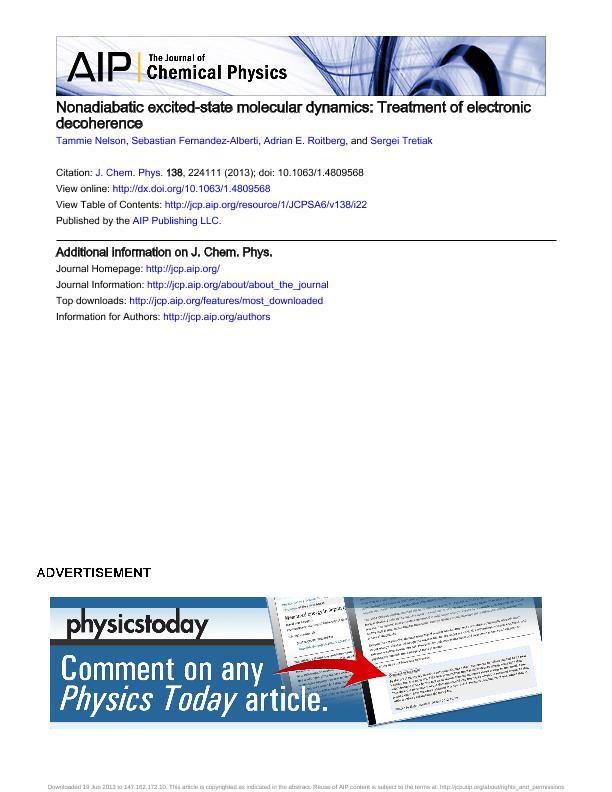Artículo
Nonadiabatic excited-state molecular dynamics: treatment of electronic Decoherence
Fecha de publicación:
06/2013
Editorial:
American Institute of Physics
Revista:
Journal of Chemical Physics
ISSN:
0021-9606
Idioma:
Inglés
Tipo de recurso:
Artículo publicado
Clasificación temática:
Resumen
Within the fewest switches surface hopping (FSSH) formulation, a swarm of independent trajectories is propagated and the equations of motion for the quantum coefficients are evolved coherently along each independent nuclear trajectory. That is, the phase factors, or quantum amplitudes, are retained. At a region of strong coupling, a trajectory can branch into multiple wavepackets. Directly following a hop, the two wavepackets remain in a region of nonadiabatic coupling and continue exchanging population. After these wavepackets have sufficiently separated in phase space, they should begin to evolve independently from one another, the process known as decoherence. Decoherence is not accounted for in the standard surface hopping algorithm and leads to internal inconsistency. FSSH is designed to ensure that at any time, the fraction of classical trajectories evolving on each quantum state is equal to the average quantum probability for that state. However, in many systems this internal consistency requirement is violated. Treating decoherence is an inherent problem that can be addressed by implementing some form of decoherence correction to the standard FSSH algorithm. In this study, we have implemented two forms of the instantaneous decoherence procedure where coefficients are reinitialized following hops. We also test the energy-based decoherence correction (EDC) scheme proposed by Granucci et al. and a related version where the form of the decoherence time is taken from Truhlar's Coherent Switching with Decay of Mixing method. The sensitivity of the EDC results to changes in parameters is also evaluated. The application of these computationally inexpensive ad hoc methods is demonstrated in the simulation of nonradiative relaxation in two conjugated oligomer systems, specifically poly-phenylene vinylene and poly-phenylene ethynylene. We find that methods that have been used successfully for treating small systems do not necessarily translate to large polyatomic systems and their success depends on the particular system under study.
Palabras clave:
Nonadiabatic
,
Molecular Dynamic
Archivos asociados
Licencia
Identificadores
Colecciones
Articulos(SEDE CENTRAL)
Articulos de SEDE CENTRAL
Articulos de SEDE CENTRAL
Citación
Nelson, Tammie; Fernández Alberti, Sebastián; Roitberg, Adrián; Tretiak, Sergei; Nonadiabatic excited-state molecular dynamics: treatment of electronic Decoherence; American Institute of Physics; Journal of Chemical Physics; 138; 6-2013; 224111-224124
Compartir
Altmétricas




